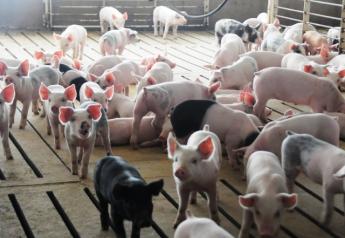Barrows and Gilts Value Difference Debunked: Is the Gilt Gap Worth Closing?

No one can deny there’s a difference between market gilts and market barrows. That’s why Ben Bohrer, meat scientist at The Ohio State University, along with collaborators Jason Woodworth and Jamil Faccin from Kansas State University decided to study the gilt gap, or the difference in performance and processing between market gilts and market barrows.
“What are the differences that you’re seeing between your market gilts and market barrows?” Bohrer asked during a session at the 2022 World Pork Expo. “What are the gaps in terms of gains, differences in terms of feed intake, differences you'd see when selling those market gilts into a packer?”
Then he asked producers to look at their lowest performing pigs. What percentage of those would be market gilts as opposed to market barrows?
“What we often find with market gilts is a decrease in average daily gain which is caused by a decrease in feed intake during the later stages of the finishing period,” he said.
But the differences don’t stop there. They carry over to the processor as well. Market gilts are oftentimes associated with lower marbling, have thinner bellies, and generate lower pounds of pork sorted for premium markets.
A New Label Claim for Improvest
In early 2020, Zoetis received FDA approval for a new claim on its Improvest product. Improvest has been used for over a decade for immunocastration in intact male pigs. The additional label claim allows Improvest to be used on market gilts to temporarily suppress estrus using a two-dose injection program. The first dose should be administered no earlier than nine weeks of age and the second dose should be given four to six weeks later, the company said in a release.
“By pausing estrus activity in the gilt with Improvest, feed intake and weight gain are improved, even during summer heat, by reducing needed nutrients for the reproductive tract during the final finishing phase and enabling further growth,” said Brian Payne, business director at Zoetis, in a release.
So why gilts? Why now? Payne said the gilt gap shows market gilts don’t perform like their counterpart barrows in the barns or at the packer, and he believes Improvest can help close that gap.
“When I walk through barns with producers, I always ask to see what pigs the producers have marked for their first cut to take to market,” Payne said. “Generally, barrows will be about 75-85% of all of the animals they mark, and the gilts are lagging behind on growth. That spread in growth delays how fast they can close out the market.”
Research has shown Improvest gilts have consistent weight gain improvements in U.S. tests of 5.5 to 7.5 lb., with increased feed intake beginning approximately seven days after the second dose.
What’s the Value to a Producer and Packer?
Chris Hodges, a swine industry consultant who’s spent 30 years in the packing industry, decided to run the numbers to evaluate potential net gains and return on investment.
“I’ve watched pigs get heavier and heavier,” Hodges said. “When I joined the industry, the average weight of a market hog was about 245 pounds. Today, it’s pushing 300 pounds. The packing industry has grown to value weight more and more.”
During the World Pork Expo session, he showed how Improvest could generate a net return of $4 to $5 a gilt for the integrators based on production efficiencies, carcass yields and discounted lightweight pigs. Bohrer found a $2 to $3 ROI for producers on a grid-based system.
“With Improvest for gilts, 7 lb. per head is the average carcass gain. I took that 7 lb. and ran it through a packing plant. What's that 7 lb. mean on roughly half the pigs?” Hodges said.
He showed how it affected various parts of the operating statement from overhead costs with the plant, the labor cost of the plant and carcass composition.
“We know that with this technology, producers can yield a higher percentage of carcass in the belly, which is far and away the highest value primal. The more carcass you put into that belly, the more value that the carcass is going to have,” Hodges explained.
Quality Counts
But it’s not just about quantity, he added. It’s also about meat quality. As premium-based export markets become increasingly important for the U.S. pork industry, more attention is being paid to pass rates.
“Pass rates are what the packing industry uses for sorting criteria – whether they are trying to sort pork for export market requirements or for premium domestic markets,” Bohrer explained.
Most export customers are very particular about the type of pork they want, he said. Things that may be considered are color, marbling, firmness and iodine value. Thresholds for each one of those parameters would be set for a given customer and then the pork would be sorted according to those parameters. This can be done on the loins, bellies, shoulders or whatever cut of meat is being sold into those premium markets.
Payne said research shows that processors get heavier, more uniform carcasses and greater value due to heavier primals, higher belly yields and increased intramuscular fat from gilts treated with Improvest. Research showed an increased intramuscular fat of 0.25% and a 2 to 3 iodine value unit reduction.
“Iodine value tells us what the melting temperature of the fat would be,” Bohrer explained. “This ultimately leads to fat firmness or softness. A lower iodine value is indicative of firmer levels of pork fat. Typically, we prefer to have firmer fat for bacon production or for chilled markets. Iodine value can give us an indication of what fat is going to look like from a quality standpoint.”
The higher fat quality not only fits the export market well, but Hodges said it fits the growing demand for a quality pork eating experience in the domestic market, too.
Packing Industry Trends
As producers look ahead, Hodges said supply chain management is very important.
“We've been through a lot of ups and downs in the last two years. First, we didn't have any pigs and then we had too many pigs. Finding a packer to think long-term with this is where a lot of this value would be recognized. When you sit down and sign a three-year agreement with a packer, you're not only talking about quantity and head supplied, but you're talking about the quality of what you're going to be bringing in over those three years,” Hodges said.
Improved meat quality and increased weight of the carcass are two things packers are looking for, he added.
“Consider the export market,” he advised. “We're competing with products from Europe, Brazil and Canada. We’ve got to up our game a little bit on quality. I find it interesting the early adopters of this Improvest technology are Canadian. Adjusting for the size of their respective pork business, Canada is exporting a much higher percentage of their produced pork into premium markets. What does that tell you?”
More from Farm Journal's PORK:







